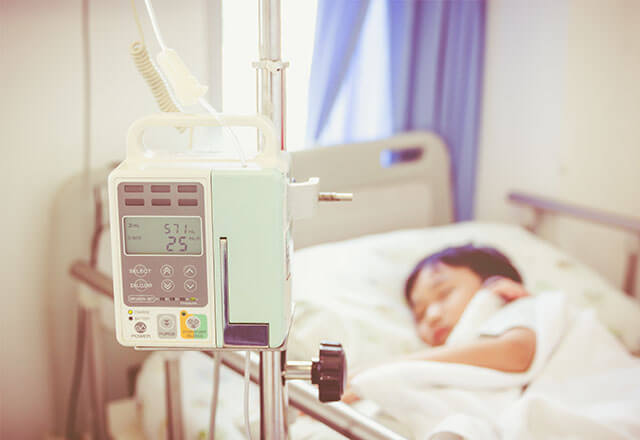Central Line-Associated Bloodstream Infections (CLABSI)
A central line is an IV that is placed into a patient’s large vein, usually in the neck, chest, arms or groin. A central line bloodstream infection (CLABSI) occurs when bacteria or other germs enter the patient’s central line and then enter into their bloodstream. Healthcare workers, patients and families can play an active role in CLABSI prevention. Most of these infections can be prevented with the correct insertion, cleaning and care practice of a central line.
What is this measure?

Johns Hopkins’ children’s hospitals, including Johns Hopkins All Childrens Hospital, The Johns Hopkins Hospital, Johns Hopkins Bayview Medical Center and Howard County General Hospital, all care for children with many complex chronic conditions. Often these conditions require a central line to be inserted to draw blood, or to give critically ill patients fluids and medications more easily. The line can be left in place for several weeks or months if needed.
Sometimes, bacteria or other germs can enter the patient’s central line and enter their bloodstream. This can cause an infection. These infections are serious, but can often be successfully treated. Johns Hopkins Medicine tracks many different infections, including patients who develop a CLABSI.
Why is it important?
Providing the best and safest care is a top priority of Johns Hopkins Medicine. The Centers for Disease Control and Prevention estimates each year there are 41,000 blood stream infections across pediatric and adult patients caused by contaminated central lines in U.S. hospitals.
Healthcare workers help prevent CLABSIs in many ways, including following specific guidelines for careful and sterile central line insertions. These guidelines are evidence-based guidelines and recommend proper maintenance of central lines and removing central lines from patients as soon as they are no longer needed.
What is Johns Hopkins doing to improve?
Providing the best and safest care to our patients is the top priority for Johns Hopkins Medicine. Part of this work includes preventing infections in the hospital, including central line associated bloodstream infections.
Johns Hopkins Medicine follows evidence-based guidelines and best practices with the goal of eliminating all CLABSIs. One of the mechanisms in place for CLABSI prevention is the use of a specific central-line insertion checklist to ensure central lines are inserted as safely as possible. The checklist details each action that must be taken before, during, and after the insertion of a central line. Johns Hopkins Medicine also uses supply bundles and kits for central lines, so that staff have all of their materials and supplies easily accessible in one place.
Monitoring adherence to best practices for central-line maintenance is also an important part of CLABSI prevention. Johns Hopkins Medicine monitors compliance with the central-line maintenance bundle, which includes the monitoring of dressings and tubing.
Johns Hopkins Medicine staff are always reassessing and evaluating if a central line is still needed with the goal of removing the central line as soon as possible.
Frontline Perspective
 According to infection control epidemiologist Taylor McIlquham, there are basic infection control practices every staff member can incorporate into their regular workflow to help reduce the risk of CLABSIs.
According to infection control epidemiologist Taylor McIlquham, there are basic infection control practices every staff member can incorporate into their regular workflow to help reduce the risk of CLABSIs.Taylor McIlquham, M.P.H.
Infection Control Epidemiologist
The Johns Hopkins Hospital
“Many of our patients require central lines — tubes that are placed in large veins to give medicine or fluids to patients — but they can be a source for bacteria or other germs to enter the patient’s bloodstream. This can cause an infection. Central line-associated bloodstream infections, or CLABSIs, are a harm that we can prevent through basic infection control practices. Preventing or reducing the risk of a CLABSI could mean a shorter hospital stay, fewer complications and less pain for patients and their families. Anything we can do to reduce this risk of harm is important to our patients.
“Our most successful strategies to prevent infections take a team approach. One of the most important things we do is ensure that everyone on the unit, from bedside nurses to environmental services staff members, understands their role in CLABSI prevention and patient safety. From the moment a central line is inserted in a patient, there are steps that every staff member can take to prevent infections and keep our patients safe.
“Our goal is to have zero CLABSIs. When a unit goes one year without a CLABSI, we recognize the staff for this accomplishment. The recognition serves as a great motivator for all of us to continue to work toward zero CLABSIs.
“I love that I have the opportunity to work with patients, family and staff from all over the hospital to prevent hospital-acquired infections and keep our patients safe.”
How can patients and family support safety?
Patients, parents, and families should alert staff members if they notice the central line dressing coming off or becoming wet or dirty. Patients and families can also ask their health care provider if they have performed hand hygiene before touching the line. They are encouraged to speak up if they have any concerns. Visitors also need to follow good hand hygiene practices by washing their hands before entering and leaving patients’ rooms.
Patients and families are provided instructions on how to care for a central line if the patient leaves the hospital while the central line is still in place.
Communicating with your Health Care Team
Hospital stays and medical treatments can be stressful for patients and families. Communication can be challenging, and it may be difficult to know what questions to ask your health care team.
Patients and families should feel empowered to ask questions, such as why the central line is needed, how long it will be in place, and which infection prevention methods will be used. They should also feel empowered to voice any concerns with their doctors, leading to better, safer health care.
Additional Resources
- The Centers for Disease Control and Prevention CLABSI Patient Education
- The Centers for Medicare and Medicaid Services' Hospital Compare
Quality and Safety Performance During COVID-19
The organization’s quality and safety performance may have been impacted by the COVID-19 pandemic. We would urge patients to consider more recent performance in combination with historical performance. Patients may benefit from discussing with their healthcare provider the disruptions COVID-19 may have caused on quality and safety of care.
See how Johns Hopkins Medicine prioritizes safety during the COVID-19 pandemic.
